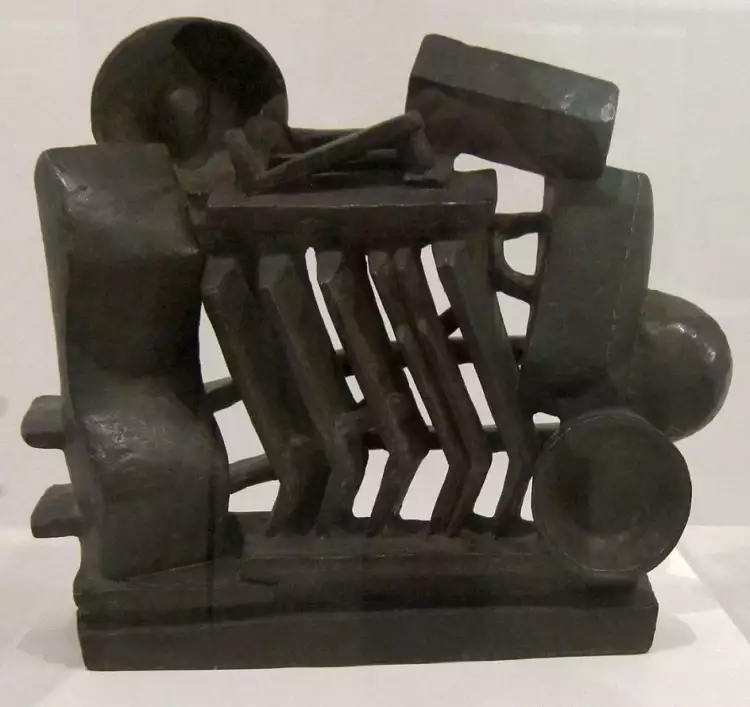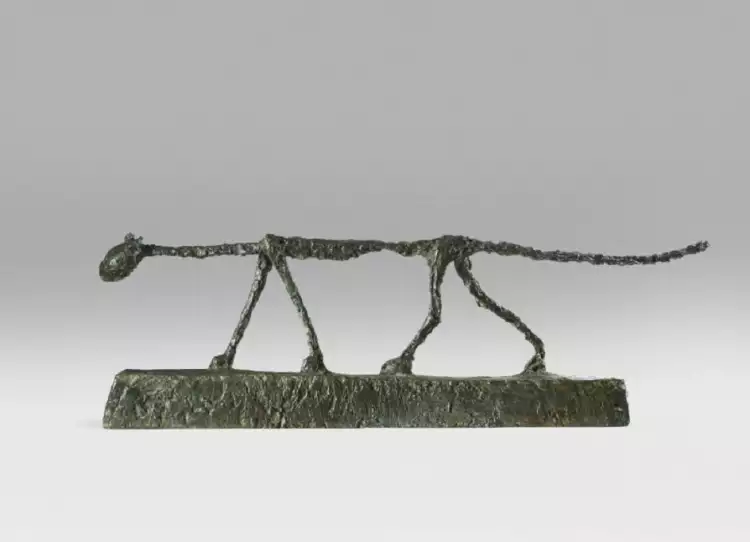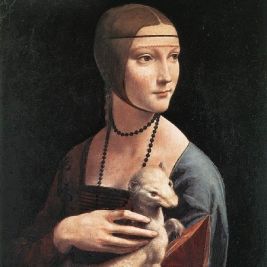
Alberto Giacometti was a great sculptor of the 20th century who relentlessly shattered the stereotypes of art in search of creative self-expression
Alberto Giacometti (October 10, 1901 - January 11, 1966) was a renowned Swiss sculptor of the 20th century, one of the most vibrant and distinctive representatives of modernism in the history of world visual arts. Alberto Giacometti was an extremely versatile artist, combining elements of several styles in his work, including Cubism, Surrealism, Expressionism, and Existentialism. His biography serves as an example of a successful career of a brilliant artist who fearlessly broke stereotypes in search of self-expression.
 Alberto Giacometti. Alberto Giacometti at the XXXI Venice Biennale, 1962
Alberto Giacometti. Alberto Giacometti at the XXXI Venice Biennale, 1962
Alberto Giacometti was also a prolific painter and graphic artist. His creative legacy includes over 1,000 plaster and bronze sculptures, several hundred paintings, and nearly 10,000 original drawings.
 Alberto Giacometti. The couple, 1927
Alberto Giacometti. The couple, 1927
Biography of Alberto Giacometti
Alberto Giacometti was born on October 10, 1901, in the small village of Borgonovo, located in the eastern part of Switzerland. His father, Giovanni Giacometti, earned a living as a painter, while his mother, Annetta, took care of the household. Alberto was the eldest of four children in the family, with his younger brother Diego later becoming a talented artist and designer, and Bruno becoming one of the most renowned Swiss architects of the second half of the 20th century.
 Alberto Giacometti. Tête qui regarde, 1928-1929
Alberto Giacometti. Tête qui regarde, 1928-1929
The future sculptor developed an interest in drawing and clay figurine sculpting at an early age. In 1919, he moved to Geneva and enrolled in the School of Fine Arts and Crafts. After mastering the basics of sculpture within 12 months, Alberto dropped out of school and embarked on an extended journey across Italy to personally witness the masterpieces of ancient and Renaissance masters.
 Alberto Giacometti. Still life, 1929
Alberto Giacometti. Still life, 1929
In 1922, Alberto Giacometti arrived in Paris to continue his studies in sculpture at the private art academy, Académie de la Grande Chaumière. In this institution, students were free to choose their disciplines and the duration of their studies, and it welcomed hundreds of foreign students and female artists. Giacometti joined the course of the renowned sculptor Emile Antoine Bourdelle, who fostered a spirit of free creativity in his students and exerted a profound influence on the development of the young artist's refined philosophical worldview.
 Alberto Giacometti. The Palace at 4 a.m., 1932
Alberto Giacometti. The Palace at 4 a.m., 1932
At the dawn of his artistic career, Alberto Giacometti created sculptures and painted paintings in a realistic style. However, after moving to France, his artistic inclinations underwent numerous transformations. Initially, the young artist became fascinated with the fashionable Cubism of the early 20th century, as well as the primitive art of the peoples of Africa, Oceania, and South America. Later, he became one of the most fervent supporters of Surrealism and created dozens of works in this modernist style.
 Alberto Giacometti. Woman Walking, 1936
Alberto Giacometti. Woman Walking, 1936
But in 1935, Alberto suddenly abandoned the Surrealist model of art and began crafting unusual sculptures—elongated human figures and heads. It was this innovative style of creativity that eventually brought the artist worldwide fame.
 Alberto Giacometti. Pointing Man, 1947
Alberto Giacometti. Pointing Man, 1947
In 1940, after the occupation of Paris by the German forces during World War II, Giacometti returned to his native Switzerland and settled in the town of Coire. There, he calmly lived through the war years, continuing to create and experiment with bronze figures. In 1949, the artist married Annette Arm, a Red Cross worker, and lived happily with her until the end of his life. They did not have children, so after the master's death, his widow became the sole inheritor of a considerable estate.
In 1962, at the Venice Biennale, the artist was awarded the main prize in the field of sculpture, marking the highest recognition of his contributions to art. This event marked the beginning of the rapid growth in popularity of the genius's work, and his solo exhibitions were held with tremendous success all over the world.
 Alberto Giacometti. Large, slim head, 1955
Alberto Giacometti. Large, slim head, 1955
However, at the peak of his professional career, the sculptor began to experience serious health problems. For many years, he was a heavy smoker, and this detrimental habit ruthlessly ravaged his body. Despite the efforts of the best Swiss doctors, on January 11, 1966, Alberto Giacometti passed away at the age of 64 in a hospital room in Coire due to pericarditis and chronic lung obstruction. According to the master's will, he was buried in his hometown of Borgonovo, next to the graves of his father and mother.
 Alberto Giacometti. Woman of Venice VII», 1957
Alberto Giacometti. Woman of Venice VII», 1957
Alberto Giacometti's Most Famous Works
The artistic legacy of the great artist comprises a vast number of original artworks. Nevertheless, among Alberto Giacometti's most famous works are:
- "Tête qui regarde" (1928-1929) — considered by experts as the first truly original sculpture of the genius. Created in the style of Cubism, this artwork represents an extremely simplified depiction of a human head with slightly curved sides.
- "The Palace at 4 a.m." (1932) — the most famous surrealist work by the master. The author himself referred to such works as "sculptures in a cage" with hidden symbolic meaning.
- "Pointing Man" (1947) — the most expensive sculpture in history. In 2015, an unknown buyer paid over $140 million at a Christie's auction for this artwork.
- "The Walking Man I" (1961) — another incredibly valuable masterpiece, which currently adorns the 100 Swiss franc banknote. In 2010, this artwork was purchased at an auction by the widow of a Lebanese banker for $103.7 million.
 Alberto Giacometti. The Walking Man I, 1961
Alberto Giacometti. The Walking Man I, 1961
Alberto Giacometti is rightly considered one of the most brilliant and original sculptors of the 20th century. His masterpieces continue to attract millions of contemporary art enthusiasts to exhibitions and are sold at art auctions for immense sums of money.

 The religious genre is profoundly spiritual and sincere art
The religious genre is profoundly spiritual and sincere art  Reproduction is an accurate copy of a work of art: its essence, distinctive features, and merits
Reproduction is an accurate copy of a work of art: its essence, distinctive features, and merits  Academism is an authoritative, virtuoso, and conservative style
Academism is an authoritative, virtuoso, and conservative style  The Rise of Generative Art: Bridging Technology and Creativity
The Rise of Generative Art: Bridging Technology and Creativity  Genre of Nude in Painting: Evolution and Historical Trends of the Nude Style
Genre of Nude in Painting: Evolution and Historical Trends of the Nude Style  Etching is a type of engraving and printing technique
Etching is a type of engraving and printing technique  Silver of Great Britain - History, Styles, and Hallmarks
Silver of Great Britain - History, Styles, and Hallmarks  The coin of 37 rubles and 50 kopecks is a valuable masterpiece of Russian numismatics with a non-standard denomination
The coin of 37 rubles and 50 kopecks is a valuable masterpiece of Russian numismatics with a non-standard denomination  An artist is a tireless creator of masterpieces of art
An artist is a tireless creator of masterpieces of art  The top 10 most famous Italian artists - the greatest masters of painting in Italy of all time
The top 10 most famous Italian artists - the greatest masters of painting in Italy of all time